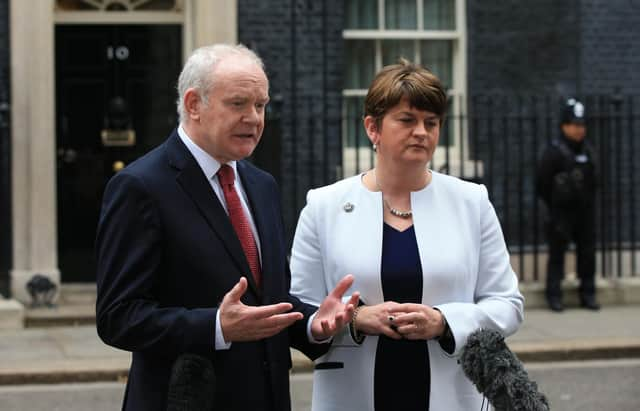Belfast Agreement @25: Nationalists saw 1998 as a process towards Irish unity, and they were right to do so - Jim Allister


(In this article I will refer to the protocol, as the changes made by the Windsor Framework are so incidental as to make little difference.)
The reason why supporters of the Belfast Agreement find common cause with the protocol is simple: both have the same trajectory and long-term goal, namely, Irish unification.
Advertisement
Hide AdAdvertisement
Hide AdThe synthesis between the agreement and the protocol is very evident.


Unionists who embraced the Belfast Agreement thought, many in good faith, that they were endorsing a settlement. Nationalists saw it rather as a process with an end goal radically different from making Northern Ireland work as a part of the United Kingdom.
Nationalism’s assessment of the agreement is and was correct.
Confirmation that the 1998 agreement’s ultimate objective is Irish unity is found in the nature and circumstances of the only referendum now provided for. It is one which effectively asks ‘Are you yet ready to join the Irish Republic?’
Advertisement
Hide AdAdvertisement
Hide AdAnd the question once asked is to be repeated every seven years until the answer is ‘Yes’. With each referendum itself held both north and south.
The means of advancing the Irish unity project through the agreement was harmonisation across the island of Ireland. Hence, the all-Ireland Ministerial Council, the multiple cross-border bodies with executive powers and the statutory obligations to liaise on an array of interests, with the guaranteed role for Sinn Fein in government a useful softening up tool.
By intensifying North/South co-operation on trade, the economy, infrastructure and health etc, the all-Ireland ethos takes root and with time the harmonisation achieved bonds the two parts of Ireland together. Such was the theory and the practice with shared services a building block.
Even, by way of example, unionist health ministers played the game with Poots and Swann embracing cross-border cancer and children’s heart surgery services – in themselves perhaps rational at an apolitical level, but with an inescapable political connotation.
Advertisement
Hide AdAdvertisement
Hide AdThe fact both parts of Ireland were in the EU and thus in a shared single market under the same customs code, made the harmonisation process easier.
Then, along came Brexit to threaten this fusion with the prospect of the UK, including Northern Ireland, diverging and taking its own course and economic direction. If the UK had left the EU, as it joined, as one nation, then, the whole harmonisation project of the Belfast Agreement was in jeopardy.
Hence, the instant campaign for ‘special status’ for Northern Ireland. It was not concern for NI’s prospects that motivated but fear of the derailing of ‘the process’ of the Belfast Agreement. When protocol supporters talk of protecting the Belfast Agreement, this is what they mean.
The first and catastrophic mistake within unionism was the then DUP leader, Arlene Foster, co-signing with McGuinness, a letter in August 2016 to the prime minister and the EU seeking special arrangements for Northern Ireland. This set in train the process which ultimately led to the Union-dismantling protocol.
Advertisement
Hide AdAdvertisement
Hide AdThe magnitude of the success of anti-Brexit forces is not to be underestimated. It has achieved what the IRA in 30 years of terror failed to achieve, namely, the driving of the border to the Irish Sea.
Now, it is the UK that is partitioned with Northern Ireland abandoned to the EU’s single market, customs code, laws and court – the same single market, customs code, laws and court as the Republic, ensuring as Great Britain diverges Northern Ireland will increasing be absorbed into the Republic’s economic orbit and order.
Little wonder Sinn Fein cannot contain its enthusiasm for the protocol, not because it is naturally Europhile, but because the protocol has achieved more for Irish unification than its IRA ever attained.
It has actually and practically achieved substantial constitutional change with the Supreme Court confirming the foundation of the economic union of the UK, Article 6 of the Acts of Union, is in suspension because of the supremacy and effect of the protocol.
Advertisement
Hide AdAdvertisement
Hide AdThe fact that such constitutional change could be made without consent from the people of Northern Ireland is proof beyond measure that the much vaunted ‘consent principle’ in the Belfast Agreement is a fraud and a deceit – leaving unionist believers in the agreement severely shaken and betrayed.
Given the kinship between the Belfast Agreement and the protocol, it is no surprise that the agreement celebrants at Queen’s University Belfast recently should have simultaneously waxed so supportive of the protocol and desperate to cajole and coerce unionists into Stormont to complete the project of implementation of their own destruction.
Any unionist who understands the true import and effect of the protocol, even if they don’t accept its correlation with the Belfast Agreement, cannot contemplate collaborating in its Union-dismantling implementation through Stormont.
Far better to disrupt this Irish unification project by resolutely standing our ground.
Advertisement
Hide AdAdvertisement
Hide AdTo do otherwise, to operate the protocol through Stormont is to accept that never again will Northern Ireland be a full part of the United Kingdom, even sooner than the Belfast Agreement anticipated.
• Jim Allister KC MLA is leader of the TUV